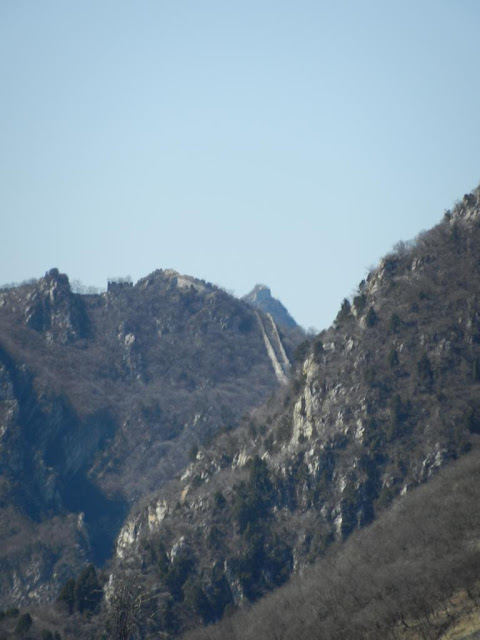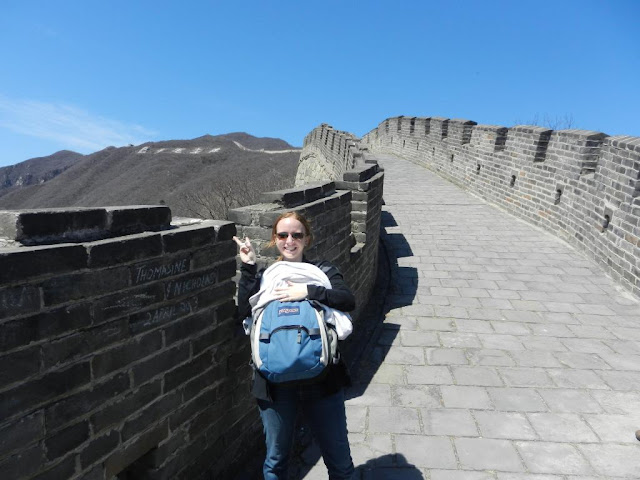I learned something about The Great Wall of China while planning a recent trip there: isn't one wall. It is really a somewhat complicated network of walls built over a the period of a couple millennia. Different sections are in various states of repair, some are connected and others aren't. Each emperor who built walls did so according to the land he controlled and the people he didn't like (mostly the Mongols and Manchus.) The scale of the thing is awe inspiring.
 |
| Map courtesy of Wikipedia |
The Chinese say you're not a real man until you've climbed the Great Wall. A little extra motivation to visit a wonder while it's still conveniently close. We had avoided trips like this last year due to the pregnancy and birth, so when my parents decided to come all the way from Illinois it was an easy decision to zip up to Beijing; the wall being the main attraction.
The Great Wall's effectiveness varied over the years with the northern invaders occupying China off and on. The luck ran out permanently at the end of the Ming dynasty after the emperor spent much effort to rebuild the wall. The Manchus of the northeast seized Beijing around 1644AD and established China's final dynasty: the Qing dynasty.
Something so old is bound to succumb to the elements over time; some areas no longer exist and the most recent sections are in the best shape. A handful of sections have been rebuilt and maintained as tourist areas. I learned from others that the Mutianyu section wasn't likely to be as crowded as other tourist areas because it was a little more difficult to access by giant tour buses that are common in China. Coupling that with the fact we went on a weekday and the place was quiet.
 | ||
| A section of unmaintained wall is barely visible with the camera set to "super zoom" mode. |
Earlier walls were built by compressing earth between wooden barriers, but this area was built (or maybe rebuilt) by the Ming dynasty with stone and brick. Cement and mortar didn't exist, so they used sticky rice to hold the walls together. Modern reconstruction used mortar, loose pieces of which are often picked up by vandals looking to leave their chalky mark on history.
The wall at Mutianyu snakes along the mountain peaks and is surrounded by forest. Some sections of that wall are quite steep causing people to look silly.
One section in particular is a very steep and long staircase, at the top of which flew a Chinese flag. Just to get to the base of these stairs was a multiple hour trek and only four out of five party members made it that far...and one of the four was relying heavily on the kindness of
 |
| The flag flew at that first guard tower on that hill in the background. |
 |
| Check the size of people to fully understand how high that flag was. |
At the bottom of the stairs, a woman and her son came down counting each step. 410(ish) steps up to the flag, a few more if you wanted to mount the mountain peak. Dad and I made it up about 30-50 steps before calling it quits but Shayne stayed strong. A woman at the top took her picture.
 |
| Queen of the Mountain |
Shayne carried the camera to the top to share what we missed. The view was really something - we lucked out with a pollution free day.
 |
| Shayne's view from the top |
 |
| Mom making the most of the bottom view. |
At a few places along the wall were constructed garrisons/watch towers/barracks. These were sort of interesting and most had a hole in the roof to climb through. The interiors had brick columns and arches supporting the heavy brick roof.
 |
| Dad spotting for Shayne, the first step is a doozy. |
At Mutianyu there are three options to get to the wall. You can ride an enclosed gondola, you can take an open air ski lift or you can hike up by foot. The gondolas and ski lifts both cost money and take you to different locations. At first we took the gondola ride together and did our sight seeing. After we finished up, Shayne and I took the ski lift back up so that we could ride the toboggan back down.
 |
| Riding the gondola up to the wall |
We've lived here long enough to know that warning signs are to be taken seriously. It's not like the US where warning signs are used to warn you about things that aren't really dangerous like hot coffee and pinch points. In China, if there is a warning sign you better pay attention because your life may be on the line.
 |
| Shayne doing the Chinese girl pose |
And for scrolling all the way to the bottom, here is your reward:





















What an interesting place to visit. Looks like a great time!
ReplyDeleteWhat a wonder creativity by a human being..This is the one the best place to visit ..Thanks for sharing this great post. It’s very enlightening. I absolutely love to read informative stuff . great wall of china tours
ReplyDelete